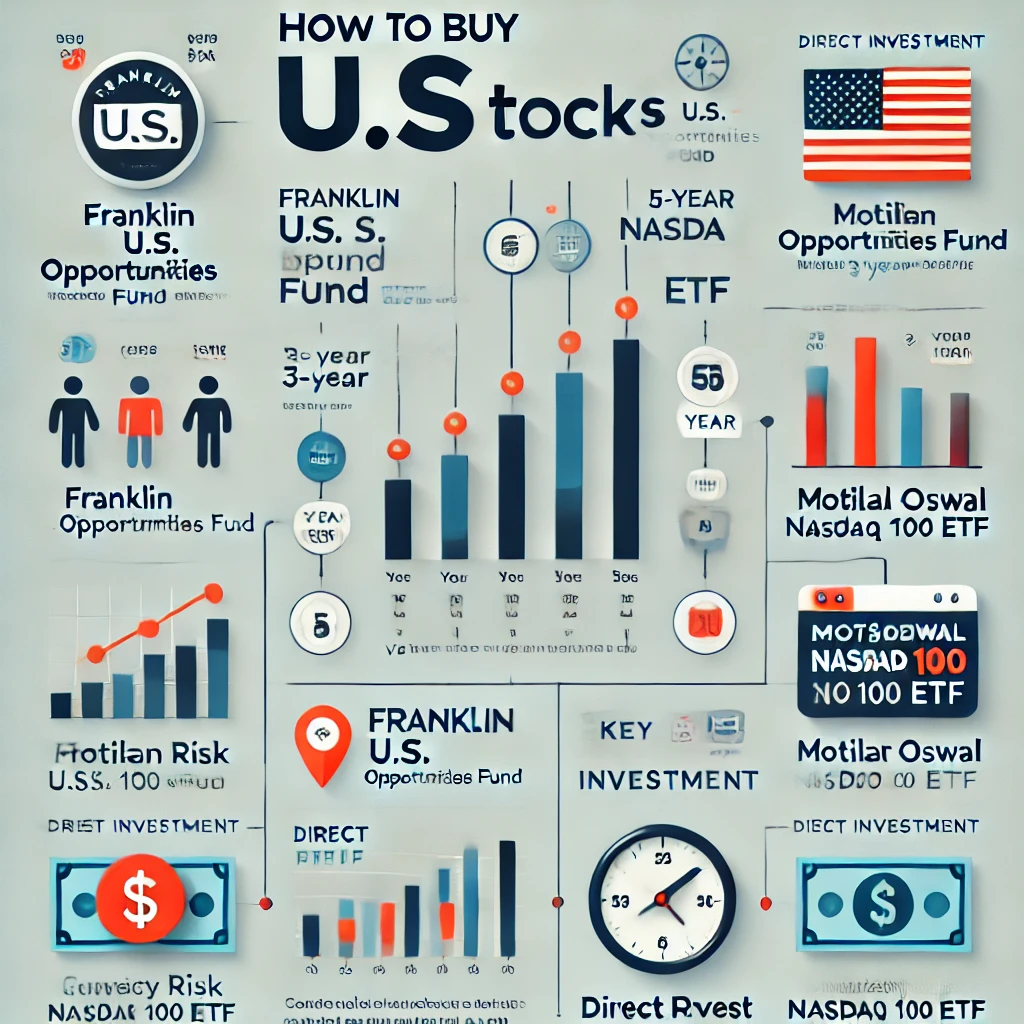Investing in U.S. stocks from India has never been easier. It allows you to diversify your portfolio by gaining exposure to leading global companies, especially tech giants. In this blog, we explore options like Franklin Templeton, Motilal Oswal, and other ways to invest in U.S. equities.
1. Franklin U.S. Opportunities Fund
The Franklin U.S. Opportunities Fund gives you exposure to some of the biggest U.S. companies, focusing on high-growth sectors such as technology and healthcare. This mutual fund is actively managed, meaning a fund manager picks and monitors the investments for you.
- 3-Year Return: ~14.62% per annum (as of 2023)
- 5-Year Return: ~14.81% per annum (as of 2023)
- Expense Ratio (Direct Plan): 1.11%
These returns reflect the fund’s ability to capture growth from U.S. equities, especially in the tech sector.
- Investment Focus: Large-cap U.S. companies like Apple, Microsoft, and Google.
- How to Invest: You can invest through Franklin Templeton’s website or via authorized distributors. SIP and lump sum options are available.
- Who Should Invest: Ideal for long-term investors looking for professional management and exposure to high-growth U.S. companies.
2. Motilal Oswal Nasdaq 100 ETF and MAFANG+ ETF
Motilal Oswal provides direct exposure to the U.S. stock market via ETFs (Exchange Traded Funds), which are passively managed and cost-effective. The two popular ETFs are:
- Motilal Oswal Nasdaq 100 ETF: Tracks the performance of the Nasdaq 100, which includes companies like Apple, Amazon, and Tesla.
- Motilal Oswal MAFANG+ ETF: Focuses on a curated list of U.S. tech giants, specifically Meta (Facebook), Amazon, Netflix, Google, and Apple.
- 3-Year Return (Nasdaq 100 ETF): ~21.58% per annum (as of 2023)
- 5-Year Return (Nasdaq 100 ETF): ~20.89% per annum (as of 2023)
- Expense Ratio: 0.50%
- How to Invest: These ETFs can be bought through your brokerage account (e.g., Zerodha, HDFC Securities , ICICIDirect), similar to trading any stock.
- Who Should Invest: Investors looking for lower costs and direct exposure to U.S. markets. ETFs are more suitable for cost-conscious investors who prefer flexibility and can manage their portfolios on their own.
3. Direct Investment in U.S. Stocks
Platforms like Vested, Stockal, or brokers like ICICI Direct allow Indian investors to buy U.S. stocks directly. This option gives you full ownership of U.S. stocks and greater control over your investments.
- How to Invest: You’ll need to sign up with a broker that supports U.S. stock trading, fund your account, and begin investing.
- Key Considerations: Exchange rates, brokerage fees, and tax implications (U.S. imposes a 15% tax on capital gains).
4. Key Considerations Before Investing
Before diving into U.S. stocks, consider these important factors:
- Expense Ratios: ETFs have lower expense ratios than mutual funds. For instance, Motilal Oswal’s Nasdaq 100 ETF charges 0.50%, while Franklin U.S. Opportunities Fund’s direct plan charges 1.11%.
- Currency Risks: Movements in the INR-USD exchange rate can impact your returns. A weaker rupee against the dollar may boost returns.
- Diversification: Investing in U.S. equities diversifies your portfolio across geographies and sectors.
- Taxation: Capital gains from U.S. stocks are taxed in both the U.S. and India. Make sure to account for this when planning your investments.
Conclusion
Investing in U.S. equities through options like Franklin U.S. Opportunities Fund or Motilal Oswal’s Nasdaq 100 and MAFANG+ ETFs provides Indian investors with convenient ways to participate in the growth of top global companies. Whether you prefer the ease of a mutual fund, the low-cost structure of an ETF, or the control of direct stock investments, there are multiple avenues to explore based on your goals and risk tolerance.
